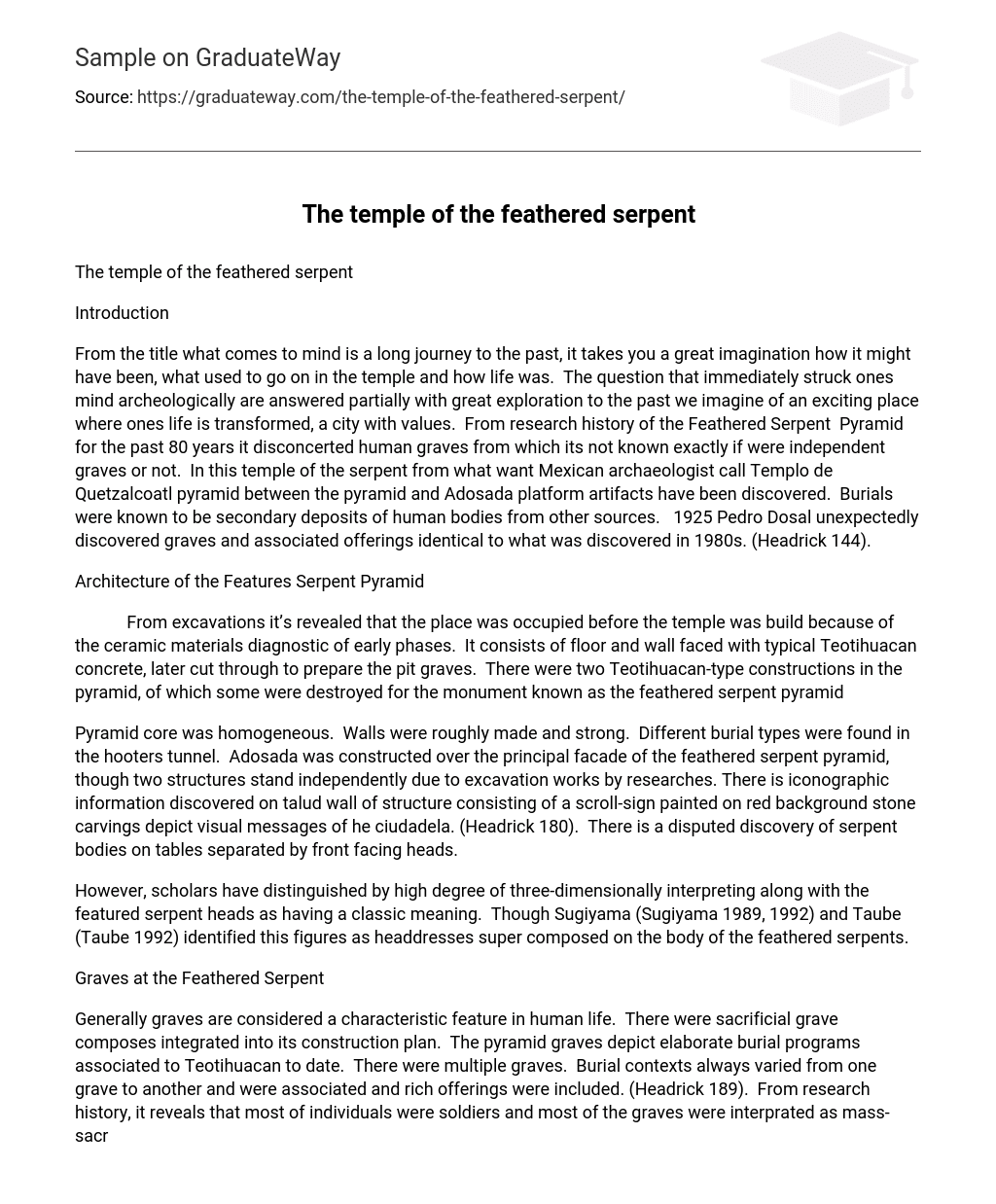Introduction
From the title what comes to mind is a long journey to the past, it takes you a great imagination how it might have been, what used to go on in the temple and how life was. The question that immediately struck ones mind archeologically are answered partially with great exploration to the past we imagine of an exciting place where ones life is transformed, a city with values. From research history of the Feathered Serpent Pyramid for the past 80 years it disconcerted human graves from which its not known exactly if were independent graves or not. In this temple of the serpent from what want Mexican archaeologist call Templo de Quetzalcoatl pyramid between the pyramid and Adosada platform artifacts have been discovered. Burials were known to be secondary deposits of human bodies from other sources. 1925 Pedro Dosal unexpectedly discovered graves and associated offerings identical to what was discovered in 1980s. (Headrick 144).
Architecture of the Features Serpent Pyramid
From excavations it’s revealed that the place was occupied before the temple was build because of the ceramic materials diagnostic of early phases. It consists of floor and wall faced with typical Teotihuacan concrete, later cut through to prepare the pit graves. There were two Teotihuacan-type constructions in the pyramid, of which some were destroyed for the monument known as the feathered serpent pyramid
Pyramid core was homogeneous. Walls were roughly made and strong. Different burial types were found in the hooters tunnel. Adosada was constructed over the principal facade of the feathered serpent pyramid, though two structures stand independently due to excavation works by researches. There is iconographic information discovered on talud wall of structure consisting of a scroll-sign painted on red background stone carvings depict visual messages of he ciudadela. (Headrick 180). There is a disputed discovery of serpent bodies on tables separated by front facing heads.
However, scholars have distinguished by high degree of three-dimensionally interpreting along with the featured serpent heads as having a classic meaning. Though Sugiyama (Sugiyama 1989, 1992) and Taube (Taube 1992) identified this figures as headdresses super composed on the body of the feathered serpents.
Graves at the Feathered Serpent
Generally graves are considered a characteristic feature in human life. There were sacrificial grave composes integrated into its construction plan. The pyramid graves depict elaborate burial programs associated to Teotihuacan to date. There were multiple graves. Burial contexts always varied from one grave to another and were associated and rich offerings were included. (Headrick 189). From research history, it reveals that most of individuals were soldiers and most of the graves were interprated as mass-sacrificial burial complex. Many of the dead were found with their wrists tied across behind their backs suggesting probably of human sacrifice thought-out there in no direct osteological evidence.
Offerings
Research reveals that to date the offerings found at the offering complex is the richest in Teotihuacan in quality, quantity and diversity. Mainly consisted of ritual objects and personnel adornments. For instance obsidian artifacts categorized into four were projectile points prismatic blades, bifuses, figurine, greenstone was used only for individual ornaments and ritual objects mainly found at central zone. Beads carspools, nose pendant, Resplandores cones and other stones. Shell offerings were found almost in every grave mostly treated as ornaments-perhaps earphones, necklaces and unworked shell. Italian jars were also discovered but no major pottery was done by their individuals (Sugiyama, 190)
Looting
Archaeological sites have always been a target for self beneficial purposes. Archaeologists have provided data about looking activities before Pre-Columbian time. Looters tunnels have been found in the pyramids, made in wood posts. Samples show that looting began and existing before the collapse of the city, it was an episode of the functioning city history and ceased in the eighth century, when metropolis was actively destroyed (Sugiyama, 217)
Conclusion
We do not know what name the Teotihuacanos had for their city and languages spoken. The Teotihuan emerged in the valley of Mexico by 300-1000B and its height in AD600 and would have held a population of approximately 125000, inhabitant. It’s notable that Nahuatl one means a place of Gods and only time will tell more due to researches conducted.
WORKS CITED
Headrick Annabeth. Precolumbian Art & Art history. 17 Sept. 1996. 1 Oct. 2008
<http://www.utexas.edu/ftp/cofa/a_ah/dir/precol/index.html
Sugiyama Saburo. The Feathered Serpent Pyramid. 20 Aug. 2001. 1 Oct. 2008.
<http:/www.archaelogy.asy.edu/Teolfsplindex





